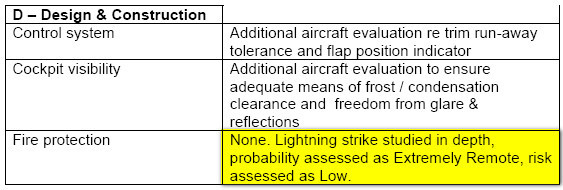Bit of a case of get there-itis when the owner got talked into flying from Grenoble to Marseille when he didn’t really think the weather was good enough for it. Pilot and passenger (also a pilot) are fine. Engine kept running, Avionics also – just one radio died. Tried to take pictures of all the exit places (there are 5) – according to the pilot a blinding flash, big bang and then lots of smoke from all the carbon burning. Everything obviously needs to be overhauled and they are not sure if the plane will ever be flyable again yet…






A very interesting post – many thanks!
I see the TKS panels carried most of the current as far as they could. I wonder whether there are any photos of a non-TKS aircraft of the same type, after a strike? It is supposed to be “ok” because they are supposed to be bonded all the way through.
It does make one wonder about non-bonded planes getting IFR approval. The LAA proposal paper says

I suppose the airplane was equipped with at least a stormscope? If so, I guess this is a good example of how insufficient that equipment is to keep you out of TS.
I have had an unpleasant encounter with lightning (in IMC) too although I was lucky enough not to be hit. Prior to the encounter I had a cell about 20 NM to my 2 o’clock. The appeared another cell at 10 o’clock 20 NM. But suddenly I was surrounded by strikes on the scope, and saw one lightning to my right and then another to my left.
The only way to keep out is weather radar or maintain VMC.
If so, I guess this is a good example of how insufficient that equipment is to keep you out of TS.
Most of all it was probably equipped with a pilot. The only “thing” that can keep you out of a TS is a decision to not fly too close to TS. We don’t know what the Stormscope showed, right?
A satellite weather receiver like the ADL120 will do most of what the radar can do by helping you to stay away from TS in IMC.
I suppose the airplane was equipped with at least a stormscope? If so, I guess this is a good example of how insufficient that equipment is to keep you out of TS.
I think it depends on the general due diligence you did before the flight.
Normally one gets the sferics picture and it’s blindingly obvious if there is any “stuff” around. With the MSLP chart being clean, and sferics being clean, in Europe, not a lot is likely in say the next hour.
Then, during flight, a stormscope will show strikes in the area, so provided you keep an eye on that (and in IMC you obviously must) you will get a warning.
I suppose it’s possible to depart with everything clean, tafs and metars clean, radar clean, etc, fly in IMC for a bit (Grenoble to Marseille is so short you could drive it in less time)

and suddenly a big CB pops up right in front of you out of nowhere. But I have never seen anything like that.
A satellite weather receiver like the ADL120 will do most of what the radar can do by helping you to stay away from TS in IMC.
For a 115nm flight?
Even the TAFs should show the usual PROB30 TEMPO TSRA etc. You can get those on a Nokia 6310.
Yes, 115NM is pretty short for a 15 minute radar picture update, but it did help me a couple of times already to say out of areas with heavy precip.
There are two statements that I read quite often that are dangerous
They are so dangerous because they are true 99% of the time, and the remaining 1% then kills you.
Convective cells can develop in minutes. Lightning can spring up very quickly, and away from cells. Fortunately, being hit by lightning away from cells is quite rare; a developing lightning bolt needs to pass within approx. 50 metres of the aircraft for the aircraft to be hit.
The alternative is to study the weather forecast and plan/cancel accordingly.
Peter wrote:
I think it depends on the general due diligence you did before the flight.
But the pilot “didn’t really think the weather was good enough for it”. That must mean that
I assume he relied on a stormscope.
All of the above is conjecture, and it would be interesting to get an account of the planning and weather avoidance strategy from the pilot himself, what equipment he used in flight and why he thinks he did not manage to avoid lightning.
It’s the 22 hangared at LFLS in aeralp ?